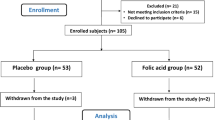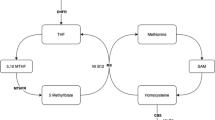Abstract
Introduction
Homocysteine is a predictor of vascular disease and may have an important role in diabetes. In this study, we examined the effects of folic acid and methylcobalamin supplementation on changes in homocysteine (Hcy) levels and homocysteine thiolactonase/paraoxonase (HTase/PON) activity in a short-term trial.
Methods
Ninety patients with type 2 diabetes were randomly divided into three groups: Group I received no vitamin supplementation, group II received 5 mg/day folic acid (orally), group III received folic acid (5 mg/day) in combination with methylcobalamin (500 μg/day; intramuscularly, on prescription). All patients were treated for 2 weeks. Plasma Hcy, HTase/PON activity, vitamin B12, and folic acid were measured before and after supplementation in each group. In addition, forty healthy (nondiabetic) controls were enrolled.
Results
Serum HTase/PON activity was significantly higher in diabetics compared with controls, plasma Hcy levels were significantly lower (P<0.05). After vitamin supplementation there was a significant reduction in plasma Hcy levels. The mean percentage reduction in Hcy was 2.75% in group I, 14% in group II and 37.3% in group III. There was a significant inverse correlation between the changes in HTase/PON activity and Hcy levels (r=−0.29, P=0.004). A 2.72% increase in HTase/PON activity was seen in group I, an 8.03% increase was detected when folic acid was given in group II (P<0.001), and a 17.59% increase in HTase/PON activity was seen in group III (P<0.001).
Conclusion
Short-term oral folic acid (5 mg/day) supplementation with or without methylcobalamin appeared to be an effective approach to decrease Hcy levels and increase HTase/PON activity in patients with type 2 diabetes. A decrease in plasma Hcy levels may partly account for the elevation of serum HTase/PON activity. This could be a novel mechanism to protect against vascular diabetic complications.
Similar content being viewed by others
References
El-Khairy L, Ueland PM, Refsum H, Graham IM, Vollset SE. European Concerted Action Project. Plasma total cysteine as a risk factor for vascular disease: the European Concerted Action Project. Circulation. 2001;103:2544–2549.
Grundy SM, Benjamin IJ, Burke GL, et al. Diabetes and cardiovascular disease: a statement for healthcare professionals from the American Heart Association. Circulation. 1999;100:1134–1146.
Hoogeveen EK, Kostense PJ, Beks PJ, et al. Hyperhomocysteinemia is associated with an increased risk of cardiovascular disease, especially in non-insulin dependent diabetes mellitus: a population based study. Arterioscler Thromb Vasc Biol. 1998;18:133–138.
Jakubowski H. Calcium-dependent human serum homocysteine thiolactone hydrolase. J Biol Chem. 2000;275:3957–3962.
Imai Y, Morita H, Kurihara H, et al. Evidence for association between paraoxonase gene polymorphisms and atherosclerotic diseases. Atherosclerosis. 2000;149:435–442.
Mackness B, Durrington PN, Abuashia B, Boulton AJ, Mackness MI. Low paraoxonase activity in type 2 diabetes mellitus complicated by retinopathy. Clin Sci (Lond). 2000;98:355–363.
Mehta KN, Chag MC, Parlkh KH, et al. Effect of folate treatment on homocysteinemia in cardiac patients: a prospective study. Ind J Pharmacol. 2005;37:13–17.
Gabir MM, Hanson RL, Dabelea D, et al. The 1997 American Diabetes Association and 1999 World Health Organization criteria for hyperglycemia in the diagnosis and prediction of diabetes. Diabetes Care. 2000;23:1108–1112.
Finkelstein JD. The metabolism of homocysteine: pathways and regulation. Eur J Pediat. 1998;157(suppl. 2)S40–S44.
Mudd SH, Levy HL, Krauss JP. Disorders of transsulfuration. In: Scriver CR, Beaudet AL, Sly WS, et al. eds. The Metabolic and Molecular Bases of Inherited Disease. 8th edition. New York: McGraw-Hill; 2000:2007–2056.
Selhub J, Jacques PF, Wilson PW, Rush D, Rosenberg IH. Vitamin status and intake as primary determinants of homocysteinemia in an elderly population. JAMA. 1993;270:2693–2698.
Koyama K, Usami T, Takeuchi O, Morozumi K, Kimura G. Efficacy of methylcobalamin on lowering total homocysteine plasma concentrations in haemodialysis patients receiving high-dose folic acid supplementation. Nephrol Dial Transplant. 2002;17:916–922.
Homocysteine Lowering Trialists’ Collaboration. Lowering blood homocysteine with folic acid based supplements: meta-analysis of randomized trials. Br Med J. 1998;316:894–898.
Kuwabara S, Nakazawa R, Azuma NI, et al. Intravenous methylcobalamin treatment for uremic and diabetic neuropathy in chronic hemodialysis patients. Intern Med. 1999;38:472–475.
Sato Y, Kaji M, Kondo I, Yoshida H, Satoh K, Metoki N. Hyperhomocysteinemia in Japanese patients with convalescent stage ischemic stroke: effect of combined therapy with folic acid and mecobalamine. J Neurol Sci. 2002;15:65–68.
Mackness MI, Durrington PN, Mackness B. How high-density lipoprotein protects against the effects of lipid peroxidation. Curr Opin Lipidol. 2000;11:383–388.
Jakubaoski H, Ambrosius W, Pratt JH. Genetic determinants of homocysteine thiolaconase activity in humans: implications for atherosclerosis. FEBS Lett. 2001;491:35–39.
Jakubowski H. Metabolism of homocysteine thiolactone in human cell cultures: possible mechanism for pathological consequences of elevated homocysteine levels. J Biol Chem. 1997;272:1935–1942.
Jakubowski H, Zhang L, Bardeguez A, Aviv A. Homocysteine thiolactone and protein homocysteinylation in human endothelial cells: implications for atherosclerosis. Circ Res. 2000;87:45–51.
Kosaka T, Yamaguchi M, Motomura T, Mizuno K. Investigation of the relationship between atherosclerosis and paraoxonase or homocysteine thiolactonase activity in patients with type 2 diabetes mellitus using a commercially available assay. Clin Chim Acta. 2005;359:156–162.
Janel N, Robert K, Chabert C, et al. Mouse liver paraoxonase-1 gene expression is downregulated in hyperhomocysteinemia. Thromb Haemost. 2004;92:221–222.
Aviram M, Rosenblat M, Bisgaier CL, Newton RS, Primo-Parmo SL, La Du BN. Paraoxonase inhibits high-density lipoprotein oxidation and preserves its functions. A possible peroxidative role for paraoxonase. J Clin Invest. 1998;101:1581–1590.
Huang RFS, Hsu YC, Lin HL, Yang FL. Folic acid depletion and elevated plasma homocysteine promote oxidative stress in rat livers. J Nutr. 2001;131:33–38.
Henning SM, Mckee RW, Seemdseid ME. Vitamins C, E, and A and heme oxygenase in rats fed methyl/folate-deficient diets. Free Radic Biol Med. 1997;23:936–942.
Author information
Authors and Affiliations
Corresponding author
Rights and permissions
About this article
Cite this article
Weijun, G., Juming, L., Guoqing, Y. et al. Effects of plasma homocysteine levels on serum HTase/PON activity in patients with type 2 diabetes. Adv Therapy 25, 884–893 (2008). https://doi.org/10.1007/s12325-008-0095-x
Published:
Issue Date:
DOI: https://doi.org/10.1007/s12325-008-0095-x




